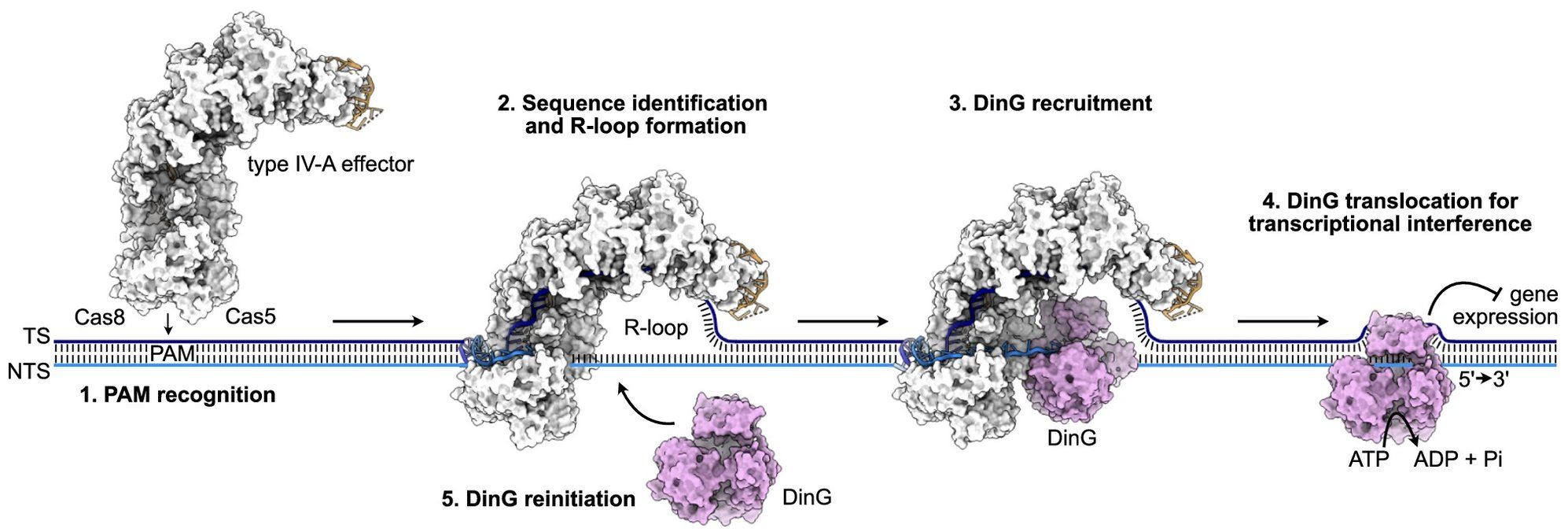|
Vilnius University researchers uncover new gene silencing mechanism Vilnius, Lithuania
Scientists from Vilnius University's (VU) Life Sciences Centre (LSC) have discovered a unique way for cells to silence specific genes without cutting DNA. This groundbreaking research, led by Prof. Patrick Pausch and published in the journal Nature Communications, reveals a new way how to silence genes that is akin to pressing a "pause" button on certain genetic instructions within cells. “Unlike the well-known CRISPR gene-editing system, often described as molecular 'scissors,' the newly studied type IV-A CRISPR system does not cut genes. Instead, it uses an RNA-guided ‘effector’ complex to recruit an enzyme called DinG, which moves along DNA and silences targeted genes in a more subtle manner.” explains Prof. P. Pausch. According to the researcher, it is fascinating how the system recognizes the precise location on the DNA to begin working: “The system uses two proteins (Cas8 and Cas5) to find a very short sequence motif adjacent to the RNA guide's complementary target DNA. Once both proteins recognize this short sequence, they melt the double-stranded DNA for target sequence interrogation.” A critical component in this process is the formation of R-loops—open DNA structures where RNA binds, signalling the system to initiate gene silencing. In his words, the DinG enzyme further enhances gene suppression by unwinding the DNA strands, allowing the system to exert its effect over a longer DNA sequence. This discovery opens doors to future applications in genome editing without the risk of DNA cuts, which could lead to more precise tools for research and biotechnology. “Our system’s unique ability to traverse DNA without cutting genes is intriguing for advanced gene-editing applications,” adds Prof. P. Pausch, who believes this new approach could benefit society by enabling safer genetic modifications.
More solutions from: Vilnius University Website: http://www.vu.lt/en Published: November 15, 2024 |



 This illustration shows the final model of the type IV-A mechanism. From left to right: Step 1 shows the formation of the "effector" complex, consisting of guide RNA and type IV-A proteins (rendered from a cryo-EM structure). The RNA-protein complex binds to a short motif next to the DNA target site (PAM). In Step 2, an R-loop forms, signalling the target site is found. Step 3 shows the binding of DinG (pink bubblegum-like structure). In Step 4, DinG likely moves along the DNA to silence the gene, potentially repeating the process for further silencing (Step 5).
This illustration shows the final model of the type IV-A mechanism. From left to right: Step 1 shows the formation of the "effector" complex, consisting of guide RNA and type IV-A proteins (rendered from a cryo-EM structure). The RNA-protein complex binds to a short motif next to the DNA target site (PAM). In Step 2, an R-loop forms, signalling the target site is found. Step 3 shows the binding of DinG (pink bubblegum-like structure). In Step 4, DinG likely moves along the DNA to silence the gene, potentially repeating the process for further silencing (Step 5).